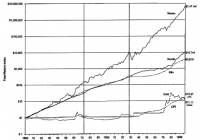A New Chinese ETF Is Better For An Arbitrage Or Just To Be Long Mainland China
Summary I’ve often written on the emerging spread between China-listed and Hong Kong-listed shares. This spread can form the basis of an arbitrage, but present ETFs have some problems in providing such arbitrage. However, there’s a new China ETF which might be better both for such an arbitrage and even just for a simple long for those wanting mainland China exposure. I’ve sometimes written about the widening gulf between Chinese shares quoted in Hong Kong (H shares) and their equivalents quoted in China’s Shanghai/Shenzhen exchanges (A shares). The last time I wrote about it was in my article titled ” There’s A Measure Of Irony In Today’s China Rally .” This spread between what are effectively the exact same shares started in November 2014, which coincided with the inception of a large bubble in Chinese stocks (quoted in China). One can follow this irrational spread by checking the Hang Seng China AH Premium Index and seeing how in years prior the index hovered in the 90-110 area as it should, and only recently it shot as high as 140-145. This means a basket of equivalent A shares is trading 40-45% above what their Hong-Kong quoted counterparts are going for. ( Source : FT.com ) I’ve said that a way to take advantage of this situation would be to arbitrage it by selling short an index fund composed of A shares and buying an index fund composed of H shares. My candidates for this were the Deutsche X-trackers Harvest CSI 300 China A-Shares ETF (NYSEARCA: ASHR ) for the short leg and the iShares China Large-Cap ETF (NYSEARCA: FXI ) for the long leg of the arbitrage. However, I’ve always had to warn that this is a very imperfect arbitrage, because the funds don’t have the same holdings – they just have some overlap where it matters. As such, this trade could only be taken for short periods of time, as any tracking error can accumulate over time. There Might Be A Better Way There is a new kind on the Chinese ETF block. I am talking about the CSOP China CSI 300 A-H Dynamic ETF (NYSEARCA: HAHA ). This ETF has unique characteristics, as follows: It replicates the CSI 300 Index, which is made up of A shares. However – and this is a key difference – whenever there’s an equivalent H share, and the H share is trading cheaper than its A share counterpart, the ETF buys the H share instead. Also, the fund carries a 75 bps expense ratio. And it’s managed by CSOP, which is the largest China A ETF manager globally, based in Hong Kong and with offices in New York. Due to the unique way this ETF is managed, it presents a much better way to implement the arbitrage I once used ASHR and FXI for. Here, the arbitrage would need to be structured as follows: A long position on HAHA. Together with a short position on ASHR, which tracks the CSI 300. The tracking error of this solution would be much smaller than the previous version, and it should correlate much better with changes to the Hang Seng China AH Premium Index. Furthermore, this ETF will probably also constitute a better alternative for those simply wanting direct exposure to China’s A share market/CSI 300. After all, it will include all of the necessary components, while also including the cheaper H shares if those are available. Not All Is Roses, Though There are a couple of issues which need to also be taken into account: HAHA is still a very recent and mostly unknown ETF, so its liquidity is very low. Furthermore, low liquidity can lead to large bid-ask spreads, much larger than either FXI’s or ASHR’s. This can be somewhat mitigated if the proper market makers tighten them, but at present, it’s clearly a problem, as it increases trading costs. Also, holding an ASHR short position, while being cheaper now, is still somewhat expensive. This is how the short rebate fee has evolved recently – as you can see, it still costs nearly 6%/year to keep an open short position: (click to enlarge) ( Source : Interactive Brokers) Conclusion There is a case to be made for using HAHA for an arbitrage to capture the Chinese A-H share spread in an arbitrage position. There is also a case to be made for using HAHA just to get long exposure to the Chinese CSI 300 index. However, a couple of problems remain in both cases, namely the lack of liquidity and thus larger trading costs, and the cost of keeping an ASHR short position open.
